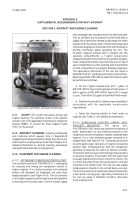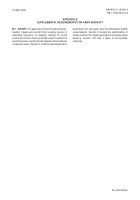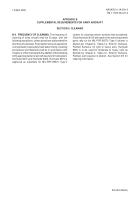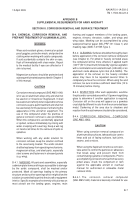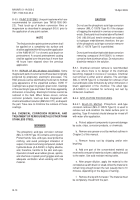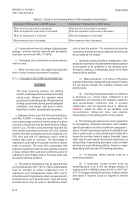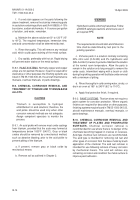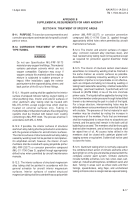TM-1-1500-344-23-2 - Page 210 of 240
B-8
NAVAIR 01-1A-509-2
TM 1-1500-344-23-2
15 April 2009
as a pretreatment prior to the application of a protective
coating. However, it also can be used to remove corrosion
products from aluminum alloy materials or items (e.g.,
skins, stringer, ribs in wings, tubing, or ducts). The wipe-
off technique is recommended for ducting, tubing,
stringer, and similar parts, followed by a thorough
rinsing of the treated area with clean water. In cases of
severe pitting, the chemical method of removal may be
aided by hand agitating (lightly) the pits with a corrosion
resistant steel wire (0.005 to 0.006 inch maximum
diameter of filament wire) brush (MIL-B-15319) or by
agitating with a power driven nylon flap brush, Density 5,
Type A, grade fine or very fine (3M Corp. or equal).
B-4.4.2. General Application Procedure.
a. Pre-clean surfaces in accordance with Chapter 2.
b. Survey or inspect equipment and determine
area(s) that should be treated with the corrosion removal
compound, using criteria cited in Chapter 3. Pitted
surfaces and/or aluminum surfaces with a powdery
metallic residue which was not removed by cleaning
should be treated. If the aircraft is being prepared for
complete painting or repainting, prepare all cleaned
bare aluminum surfaces for treatment.
B-4.4.3. Mask Applicable Areas (see B-4.1.).
c. Set up application equipment, put on protective
clothing, and prepare corrosion removal and prepaint
solution by diluting Type I material with an equal volume
of water before using. Mix the compound in wood,
plastic, or plastic lined containers only. Follow the
manufacturers mixing instructions.
NOTE
SAE AMS 1640 Type I corrosion removal
solution has a one year shelf life; therefore, it
shall not be used after one year from the date
of manufacture. SAE AMS 1640 Type II material
should be used within 90 days after dissolution.
d. Apply the corrosion removal solution by spray,
mop, sponge, or brush. When applying a the solution on
large surface areas, begin application on lower surface
and work upward, with a circular motion, brushing
enough to loosen the surface film. Allow the solution to
remain on the surface for approximately 12 minutes,
then rinse away with clean tap water. Chromate
conversion coating (MIL-DTL-81706) shall be applied
immediately thereafter. Refer to Chapter 5 for prepaint
treatment application instructions.
NOTE
The final protective paint system or primer shall
be applied only on a completely dry surface
within 48 hours after applying the conversion
coating. A second conversion coating shall be
applied over the previous application if more
than 48 hours has elapsed since the first
conversion coating was applied.
B-5. CHEMICAL CORROSION REMOVAL AND
TREATMENT OF MAGNESIUM ALLOYS.
WARNING
When preparing the chromic acid pickle solution,
add chromium trioxide to water; do not add
water to chromium trioxide.
B-5.1. The chromic acid pickle solution described herein
may be used to remove surface oxidation and light
corrosion products from magnesium surfaces. It is not
considered adequate where deep pitting or heavy
corrosion has occurred, which require mechanical
methods, nor is it satisfactory for removing sand or the
effects of blasting. The chemical method causes less
reduction in section thickness. This method shall not be
used for parts containing copper based inserts unless
the inserts are masked off. Excessive amounts of anions,
such as chlorides, sulfates, and fluorides, must not be
allowed to build up in the solution, as these anions tend
to coat or etch the metal rather than clean the surface.
B-5.2. CHROMIC ACID PICKLE SOLUTION. Mix 24
ounces of chromic acid and enough water to make one
gallon in a container constructed from lead lined steel,
stainless steel, or 1100 aluminum.
B-5.3. APPLICATION PROCEDURE.
a. Mask off nearby operating mechanisms, cracks,
and plated steel to keep the solution from attacking
them.
b. Heat the solution to 190
°
to 202
°
F (88
°
to 94
°
C).
The solution can be applied at room temperature for a
longer reaction time, if desired.
c. Carefully apply the chromic acid solution to the
corroded area with an acid resistant brush (H-B-643).
Allow the solution to remain on the surface for
approximately 15 minutes.
Back to Top


